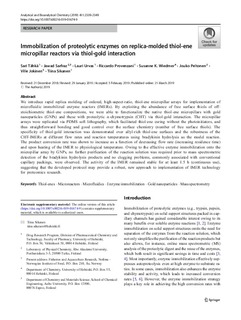| dc.description.abstract | We introduce rapid replica molding of ordered, high-aspect-ratio, thiol-ene micropillar arrays for implementation of microfluidic immobilized enzyme reactors (IMERs). By exploiting the abundance of free surface thiols of offstoichiometric thiol-ene compositions, we were able to functionalize the native thiol-ene micropillars with gold nanoparticles (GNPs) and these with proteolytic α-chymotrypsin (CHT) via thiol-gold interaction. The micropillar arrays were replicated via PDMS soft lithography, which facilitated thiol-ene curing without the photoinitiators, and thus straightforward bonding and good control over the surface chemistry (number of free surface thiols). The specificity of thiol-gold interaction was demonstrated over allyl-rich thiol-ene surfaces and the robustness of the CHT-IMERs at different flow rates and reaction temperatures using bradykinin hydrolysis as the model reaction. The product conversion rate was shown to increase as a function of decreasing flow rate (increasing residence time) and upon heating of the IMER to physiological temperature. Owing to the effective enzyme immobilization onto the micropillar array by GNPs, no further purification of the reaction solution was required prior to mass spectrometric detection of the bradykinin hydrolysis products and no clogging problems, commonly associated with conventional capillary packings, were observed. The activity of the IMER remained stable for at least 1.5 h (continuous use), suggesting that the developed protocol may provide a robust, new approach to implementation of IMER technology for proteomics research. | |
